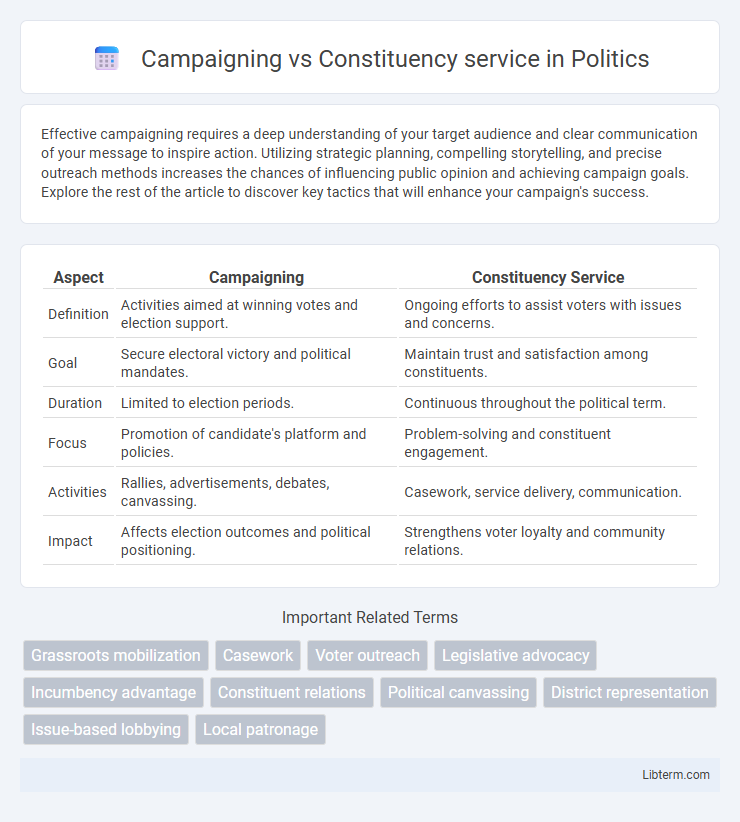Effective campaigning requires a deep understanding of your target audience and clear communication of your message to inspire action. Utilizing strategic planning, compelling storytelling, and precise outreach methods increases the chances of influencing public opinion and achieving campaign goals. Explore the rest of the article to discover key tactics that will enhance your campaign's success.
Table of Comparison
| Aspect | Campaigning | Constituency Service |
|---|---|---|
| Definition | Activities aimed at winning votes and election support. | Ongoing efforts to assist voters with issues and concerns. |
| Goal | Secure electoral victory and political mandates. | Maintain trust and satisfaction among constituents. |
| Duration | Limited to election periods. | Continuous throughout the political term. |
| Focus | Promotion of candidate's platform and policies. | Problem-solving and constituent engagement. |
| Activities | Rallies, advertisements, debates, canvassing. | Casework, service delivery, communication. |
| Impact | Affects election outcomes and political positioning. | Strengthens voter loyalty and community relations. |
Understanding Campaigning and Constituency Service
Campaigning involves strategic efforts to communicate a candidate's platform, mobilize voters, and secure electoral support through advertisements, rallies, and canvassing. Constituency service centers on addressing the needs and concerns of constituents by providing assistance with government services, resolving issues, and maintaining ongoing communication. Understanding the distinction highlights campaigning's goal to win elections, while constituency service fosters long-term voter relationships and trust.
Key Differences Between Campaigning and Constituency Service
Campaigning involves efforts to secure voter support through outreach, messaging, and mobilization before and during elections, focusing on persuading and gaining new voters. Constituency service centers on addressing the needs and concerns of existing constituents by providing assistance, resolving issues, and maintaining ongoing engagement. The key differences lie in the timing, objectives, and interactions: campaigning is proactive and election-driven, while constituency service is reactive and focused on constituent satisfaction and retention.
The Role of Campaigning in Modern Politics
Campaigning in modern politics drives voter engagement through targeted messaging, digital outreach, and data analytics, shaping public opinion and mobilizing support. It establishes candidate visibility and policy platforms, influencing election outcomes significantly more than traditional constituency service activities. Effective campaigns leverage social media, media advertising, and grassroots efforts to build momentum and secure electoral success.
Importance of Constituency Service for Elected Officials
Constituency service is crucial for elected officials as it directly addresses the needs and concerns of their constituents, fostering trust and long-term support. Effective constituency service enhances an official's reputation and legitimacy by providing personalized assistance with government services and addressing local issues. This focused engagement often translates into increased voter loyalty and can significantly impact re-election success.
Strategies for Effective Campaigning
Effective campaigning strategies prioritize targeted voter outreach, leveraging data analytics to identify and mobilize key demographics. Crafting compelling, issue-focused messaging tailored to constituency values enhances voter engagement and trust. Integrating digital platforms with grassroots efforts maximizes reach and fosters continuous supporter interaction throughout the election cycle.
Building Trust Through Constituency Service
Building trust through constituency service requires consistent, personalized engagement and addressing individual or community needs promptly. Effective constituency service demonstrates a politician's reliability and commitment, fostering long-term loyalty beyond election cycles. This trust foundation often translates into stronger support during campaigning, making service a critical strategy for sustained political success.
Balancing Campaign Efforts and Serving Constituents
Balancing campaign efforts and serving constituents requires strategic time management to ensure ongoing voter engagement without neglecting community needs. Effective politicians allocate resources to maintain visibility during campaigns while providing responsive services that build trust and long-term support. Prioritizing transparent communication and addressing constituent concerns enhances reputation, directly impacting both immediate electoral success and sustained political influence.
Impact of Campaigning on Voter Perception
Campaigning significantly shapes voter perception by highlighting a candidate's policy positions, charisma, and responsiveness to public concerns, which can sway undecided voters and reinforce support among loyalists. Effective campaigning uses targeted messaging, media engagement, and grassroots mobilization to create an emotional connection and build trust with the electorate. This dynamic often results in increased voter turnout and can alter the overall electoral landscape by redefining candidate viability and issue salience.
Case Studies: Success Stories in Campaigning vs Constituency Service
Case studies reveal distinct success stories in campaigning and constituency service, highlighting how targeted messaging during campaigns increased voter turnout by 15% in the 2020 U.S. Senate race. Constituency service success is exemplified by a local councilor in Manchester who resolved over 1,200 community issues within a year, boosting public approval ratings by 30%. These examples emphasize strategic engagement's role in both mobilizing support and sustaining trust in political leadership.
Future Trends in Political Campaigning and Constituent Relations
Future trends in political campaigning emphasize data-driven strategies, social media engagement, and personalized voter outreach to enhance precision and impact. Constituency service is expected to integrate advanced technology such as AI-powered communication tools and real-time feedback systems to strengthen representative responsiveness and foster trust. The convergence of digital platforms and analytics will reshape how politicians balance campaign efforts with ongoing constituent relations, promoting transparency and sustained engagement.
Campaigning Infographic

 libterm.com
libterm.com